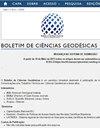地下公用事业网地籍建议,基于ladm (iso / fdis 19152)
IF 0.5
Q3 Earth and Planetary Sciences
引用次数: 6
摘要
地表上下空间的使用日益增加,提出了控制其占用的需要。基础设施地下网络的本地化是一项重大挑战,对于大多数国家来说,这些信息尚未可用或不易获取。在这个关键时刻,管网选址地籍对供水管理系统至关重要。2012年的ISO 19152 -土地管理领域模型(LADM) -以一种简单的方式解决了地籍系统共同特征的标准化和集成,并可应用于土地管理的几个方面。在此背景下,本研究旨在基于LADM提出的标准开发地下水公用网络模型。ISO 19152建议的模型的实施使用COMPESA水公用事业网络地籍作为研究案例进行了测试。公司采用的现代化和技术进步促进了对地理数据库底层结构的理解和对其与国际标准的适应。建模采用UML语言,物理实现采用DBDesigner,并结合PostgreSQL/PostGIS和QGIS执行。本文章由计算机程序翻译,如有差异,请以英文原文为准。
SUBSURFACE UTILITY NETWORK CADASTRE PROPOSAL, BASED ON LADM (ISO / FDIS 19152)
The increasing usage of the space above and underneath the land surface brings up the need of controlling its occupation. The localization of the infrastructure underground network is a major challenge, and for most of the countries, this information is not yet available or not easy to access. At this juncture, the cadastre of the network location is of fundamental importance for the water management supply systems. ISO 19152 from 2012 - Land Administration Domain Model (LADM) - addresses the standardization and integration of common features of cadastre systems in a simple way, and may be applied to several aspects of land administration. Within this context, this research aims to develop a model of subsurface water utility networks, based on the standard proposed by LADM. The implementation of the model suggested by ISO 19152 was tested using the COMPESA cadastre of the water utility network as a study case. The modernization and the technological advances adopted by the company facilitated the understanding of the geographical database underlying structure and its adaptation to the international standard. The modeling was produced using UML language, and DBDesigner for the physical implementation, executed in connection with PostgreSQL/PostGIS and QGIS, was applied.
求助全文
通过发布文献求助,成功后即可免费获取论文全文。
去求助
来源期刊

Boletim De Ciencias Geodesicas
Earth and Planetary Sciences-General Earth and Planetary Sciences
CiteScore
1.70
自引率
20.00%
发文量
10
审稿时长
3 months
期刊介绍:
The Boletim de Ciências Geodésicas publishes original papers in the area of Geodetic Sciences and correlated ones (Geodesy, Photogrammetry and Remote Sensing, Cartography and Geographic Information Systems).
Submitted articles must be unpublished, and should not be under consideration for publication in any other journal. Previous publication of the paper in conference proceedings would not violate the originality requirements. Articles must be written preferably in English language.
 求助内容:
求助内容: 应助结果提醒方式:
应助结果提醒方式:


